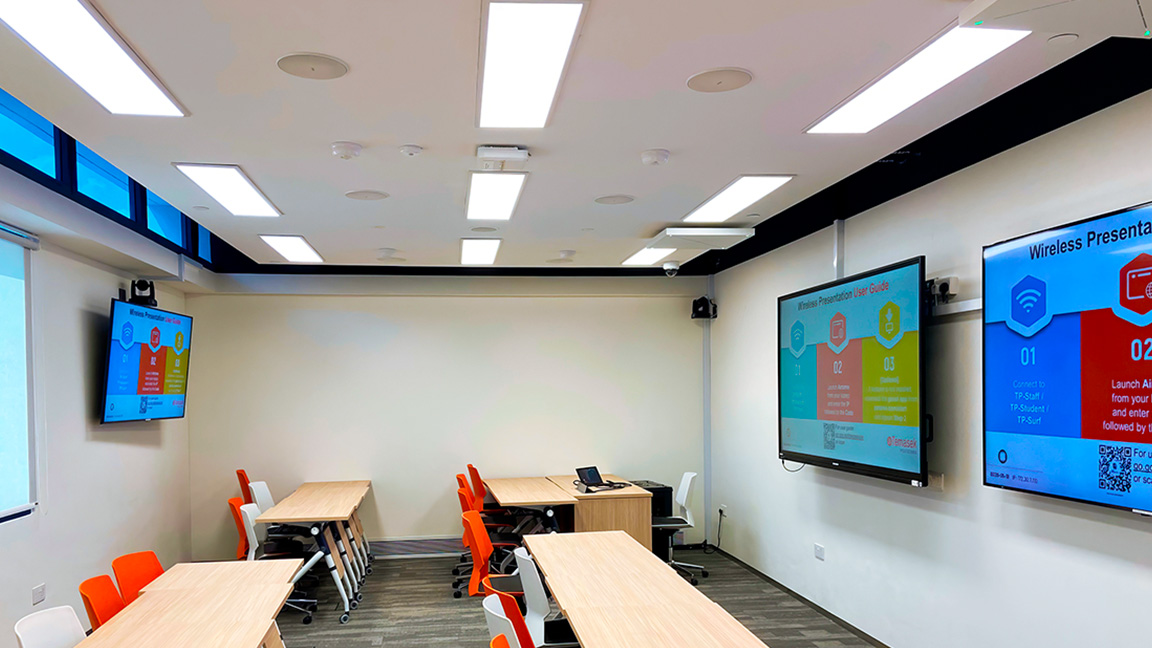What you thought you knew about in-ceiling speakers yesterday is not what you know about in-ceiling speakers today. The hybrid world—whether it is solutions (like videobars) or features (like AI)—continues to evolve as we push toward a more equitable space for both the in-person and remote experience. The same is true for restaurants or retail environments that require uniform audio delivery throughout, whether it is for background music or emergency notifications.
Hearing what needs to be heard is important to everyone’s experience, but we don’t necessarily want to see obtrusive devices delivering said audio. So, what are we looking for with the latest in-ceiling microphone technology?

“There are a multitude of uses for ceiling speakers in the professional market,” explained Nalle Magnusson, product manager at Shure. “Among the most popular uses are meeting rooms, public spaces, and any flexible spaces that require an evenly distributed audio system that is out of sight, but still delivers a good listening experience. The system often provides speech amplification for the meeting room, either from a far-end codec or an in-room microphone system. For other spaces, the ceiling speaker system provides music, evacuation messaging, or similar.”
To Use, Or Not to Use
Why consider in-ceiling speakers in the first place? “One of their primary advantages is their ability to maintain a clean aesthetic, particularly when visible in-room speakers are not preferred,” said Alexander Zaliauskas, director of product management, speakers, Snap One. “Architects specify ceiling speakers to blend into environments seamlessly, sometimes integrating them with LED lighting fixtures for a cohesive design.”
“In commercial applications, in-ceiling speakers are most often used to achieve uniform sound coverage,” added Tom Oliver, Vanco’s sales director for commercial AV. “That’s a goal for a wide range of applications, including videoconference rooms, public address, emergency notifications, voice reinforcement, and program audio.”
“Distributed audio systems are probably the biggest segment for these devices—in any space where you want music or any kind of ambient sound everywhere,” added Joel Mulpeter, director of product marketing for Creston.

But in-ceiling speakers are not an ideal solution for every project. According to Paul Harris, Aurora Multimedia’s CEO and CTO, there’s not much use for ceiling speakers in smaller rooms where the display speakers or a soundbar can be utilized. And Magnusson said that in certain situations, it can be difficult to achieve the necessary gain before feedback due to the lack of dispersion control inherent in a ceiling speaker system. “In these cases, a point-source/directional speaker or line array system may be necessary thanks to their much more precise audio dispersion,” he said.
[Evaluating the Office Space Identity Crisis]
When it comes to conferencing and massive spaces, in-ceiling speakers are best for larger meeting rooms and paging speakers. But there are still some challenges. “The construction and aesthetic of some spaces isn’t conducive to in-ceiling speakers. If the ceilings are extremely high, or the space has an industrial design with exposed rafters, you may want to opt for in-wall, wall-mounted, or pendant speakers instead,” Oliver added. “You also have to consider bleed-through to adjacent spaces—though with the right speaker or backbox design, you can overcome that issue.”
Design Considerations
Once the decision is made to go with in-ceiling speakers, plotting the design is imperative to achieve optimal audio and clarity—or as Mulpeter said, it takes “planning, planning, and more planning.”
Magnusson offered a number of questions to consider: “Is the room suitable for an in-ceiling system? Is there space above the ceiling to easily install and pull cables? Should it run on 70V, LoZ, or be networked? Can the speakers be placed to minimize reflections from the walls? How will the room be used? In-room microphone system amplification? Far-end amplification? Music? Only by fully understanding these requirements can you design a suitable system."
“Intelligibility, uniformity, and user experience are the most important factors,” opined Oliver. “The AVIXA Audio Coverage Uniformity Standard offers a great foundation for in-ceiling loudspeaker system design.”

And don’t forget the customer. “Qualifying the customer and asking the right questions are crucial steps in identifying the best solution for your customer,” said Zaliauskas. “Factors such as budget, performance expectations, room layout, aesthetic considerations, and intended usage all play pivotal roles in determining the most suitable in-ceiling products among the myriad of options available.”
Can you consider in-ceiling speakers for outdoor locations, such as restaurant patios? “If the client prefers them, why not?” Mulpeter said. “We’re seeing more outdoor spaces that function as 'rooms' unto themselves, and if a space has a permanent ceiling, there’s no reason why a weather-resistant device can’t go into that ceiling. We designed many of our audio products to handle marine deployments as a baseline for durability, reliability, and weather resistance—if the gear can handle the rigors of the open ocean, it can handle a patio."
“Intelligibility, uniformity, and user experience are the most important factors.”
Tom Oliver, Vanco
“Some in-ceiling speakers can be mounted in a pendant enclosure for outdoor and other applications,” Oliver added. “Of course, you must be certain the enclosure is appropriately rated for outdoor use in your local environment. Most regions in North American need IP65-rated gear to resist typical weather and particle exposure.”
On the Network?
How about networking an in-ceiling speaker system? Simply put, it depends.

Oliver said the ROI of networked speakers is directly related to the size and complexity of the project. “If you’re creating a sound system for a large stadium, networked audio can dramatically simplify distribution,” Oliver said. “For a sports bar or conference room, probably not.”
“In commercial installations, particularly large-scale ones, networked speakers have experienced rapid adoption,” said Zaliauskas. “This is primarily due to the scalability and advanced audio routing capabilities offered by audio-over-IP systems. These networked solutions streamline audio distribution and management, making them well-suited for complex commercial environments where flexibility and control are paramount.”
"Networked audio allows the addition of an incredible range of sources, from streaming to pro audio connections to physical media," Mulpeter added. "The ability to scale up and send flawless audio at longer distances without sacrificing quality is another huge factor.”
For paging or fire safety systems, networked audio can be very useful to monitor individual speakers and "the amplification can be segmented and powered from the switch," Harris said. "It also allows for zone/speaker specific notification—and if the speaker has a microphone feature, it can even become a two-way intercom. For a conference room, it’s not as necessary—but with the right solution, it can simplify installation, as the audio would be distributed by Dante/AES67 and eliminate the need for an amplifier mounted somewhere in the room.”
The Sub Routine
As more corporate venues and meeting spaces look toward a complete, comprehensive sound system, some installations feature a subwoofer with the in-ceiling speakers. While more of a luxury than necessity, most of our experts agreed there is a place for one in the right environment.

“The 'whys' of an in-ceiling sub are often related to pure practicality—the client’s office is a glass box, for example,” Mulpeter explained. “Or perhaps they’re retrofitting an old building in London or Boston with thick masonry walls. In any case, sound mitigation will probably be a big consideration. Those low frequencies can travel long distances, and the folks in the office above yours don’t want to hear the Death Star exploding.”
“It's essential to recognize that no single speaker can fully reproduce the entire audio spectrum with optimal effectiveness," noted Zaliauskas. “Ceiling speakers, for instance, have a limited cone area, impacting the extent of bass reproduction they can achieve. While digital signal processing [DSP] and other tools can enhance perceived bass through psychoacoustic techniques, there are scenarios where supplementing with a subwoofer becomes necessary to meet customer expectations in terms of performance."
But not all experts are fans of ceiling-based subwoofers. While Harris said a subwoofer can add liveliness to music or movies, one isn't necessary for unified communications, as speech doesn't require the very low frequencies of a subwoofer. "Personally, a subwoofer in a ceiling is a poor choice, as the low frequencies are more likely to make things rattle in the ceiling and the vibrations are more likely to travel to other rooms,” he added.
There are plenty of in-ceiling speakers out there for a wide array of use cases. Let us help you get started in finding the right one with the following manufacturers.
AtlasIED IsoFlare Series
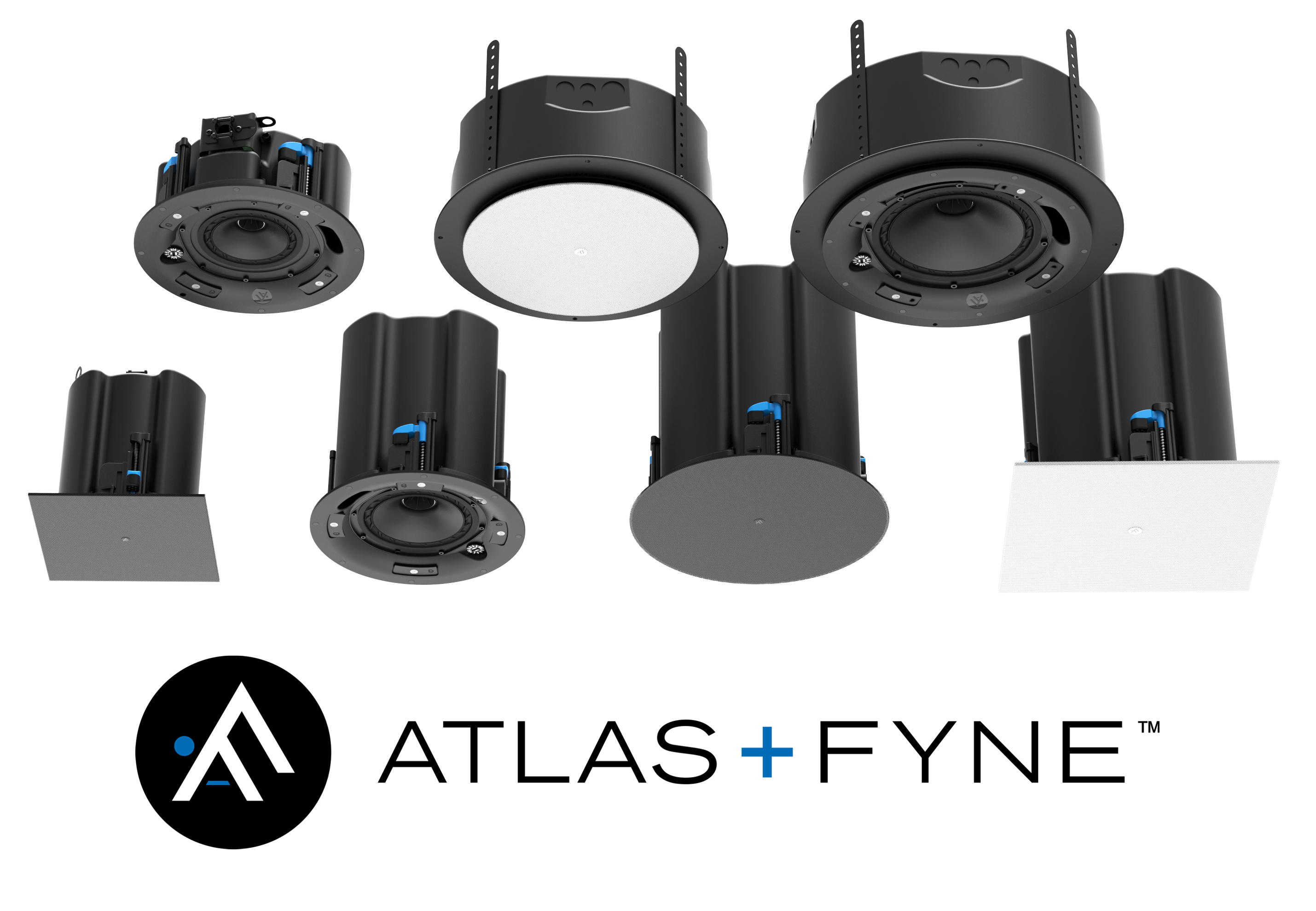
The AtlasIED IsoFlare Series of premium ceiling loudspeakers are ideal for luxury hotels, casinos, high-end restaurants and bars, retail spaces, and corporate facilities. Its point-source technology provides a natural and accurate soundstage, accurate and linear response, and consistent broadband directivity. The series consists of seven models, including blind mount models in 4, 6, and 8-inch sizes, a 4-inch low profile model, an 8-inch subwoofer, and two pre-install models. The loudspeakers offer an edgeless grille design in either square or round with black and white options. For quick and secure installation, the IsoFlare Series incorporates a patented toolless dog leg mounting mechanism on all models.
Aurora Multimedia SKR-22T-XFR
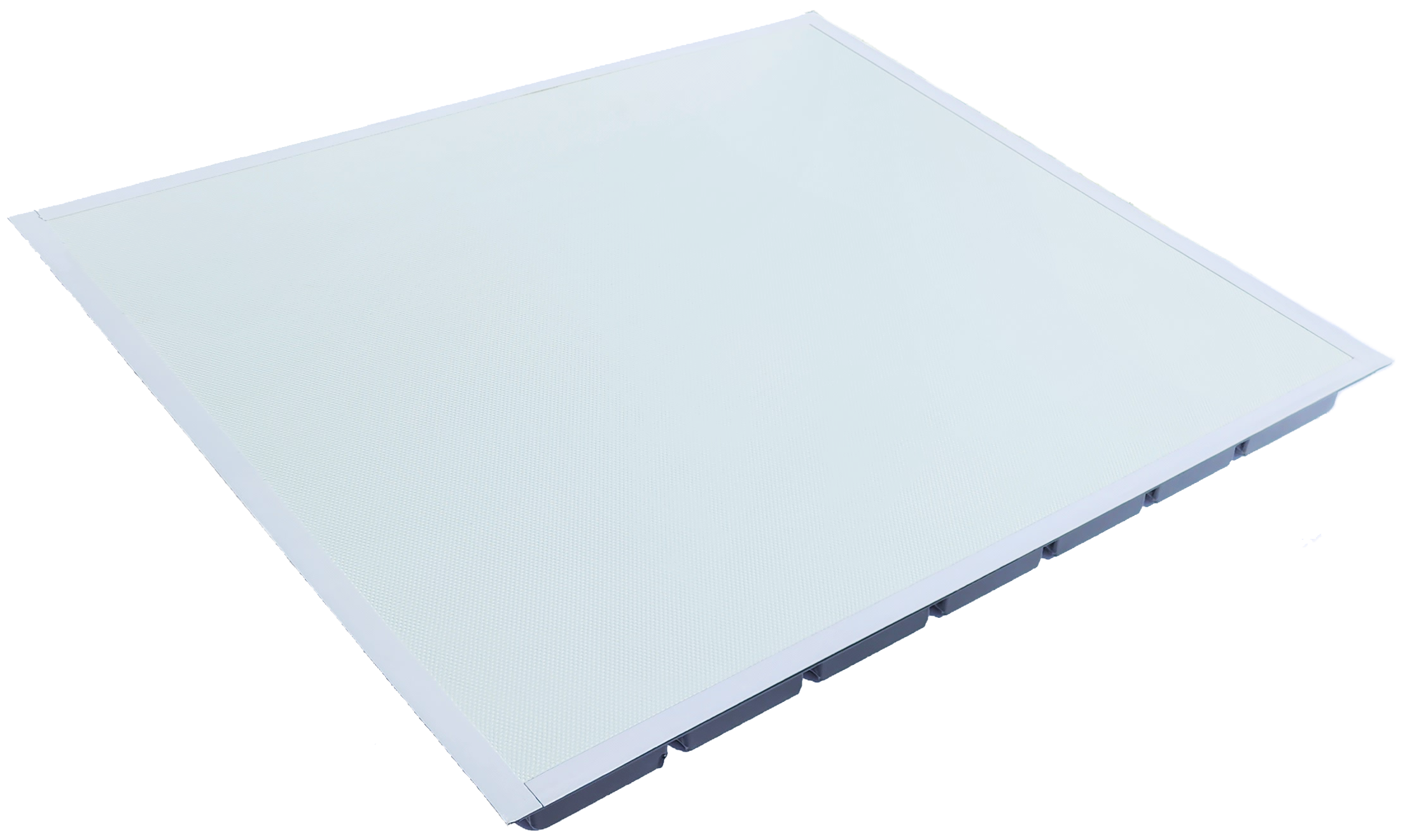
This lightweight speaker delivers clear sound with fidelity not normally found on typical ceiling speakers. Its ability to reproduce a 180-degree sound field allows the use of only one speaker in a room for mono operation. Installation is quick, as well as less costly and less messy, as there is no cutting of ceiling tiles or back boxes to mount. Just drop the tile into a 2x2 ceiling grid, connect the speaker wire, and you are done. For 4x2 ceiling grids, just cut the tile in half and add a standard ceiling divider. With a full range of audio, presenters sound clear and presentation material is produced without missing the lows or the highs compared to typical 5-inch round ceiling speakers.
Bluesound Professional BCS300
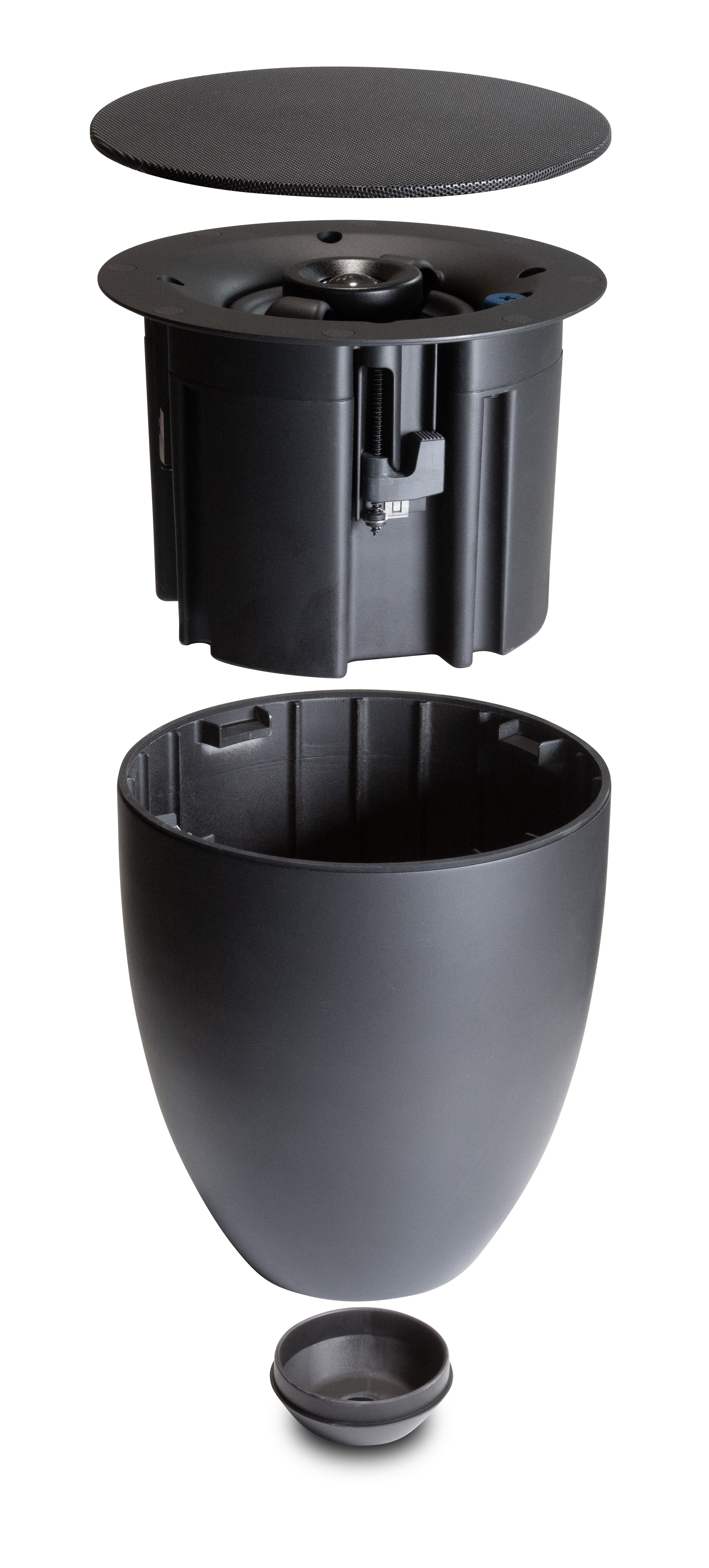
The BCS300 network streaming ceiling speaker is a patented “all-in” solution. PoE technology enables a single Ethernet cable to deliver both power and network connectivity to the built-in amplifier and audio streamer, while the BluOS platform brings in natively integrated commercially licensed audio streaming services like SOUNDMACHINE and Sirius XM for Business. Other features include distribution control for dozens of zones and XYTE remote monitoring. As a decentralized solution, it is easy to install new or retrofit into existing systems, while the optional pendant kit quickly converts it to a hanging pendant speaker.
Bose Professional EdgeMax EM180

Bose Professional’s EdgeMax series combines high-fidelity sound with unique directionality to break free of the limitations of the in-ceiling loudspeaker category. EdgeMax sounds like a surface-mount loudspeaker, looks like an in-ceiling loudspeaker, and directs sound asymmetrically into spaces where traditional loudspeakers can’t go. Patented PhaseGuide technology creates a coverage profile unique to Bose speakers. Instead of firing downward in a cone-shaped pattern like traditional ceiling speakers, EdgeMax projects sound into the room to deliver high-quality performance and directionality.
Crestron Saros IC6T

Saros speakers are designed to deliver enhanced speech intelligibility and full music reproduction for use in boardrooms, classrooms, restaurants, nightclubs, retail spaces, houses of worship, and convention facilities. Designed for quick and easy installation and years of reliable performance, the Saros IC6T is a two-way in-ceiling speaker featuring a 6.5-inch woofer and wide-dispersion, horn-loaded 1-inch dome tweeter. A built-in 60W multi-tap transformer allows for use with 70V and 100V distributed speaker systems. Power handling at 8 ohms is 125W (program), with a wide frequency response from 50 Hz to 20 kHz (±3 dB).
Extron SoundField XD SF 26CT
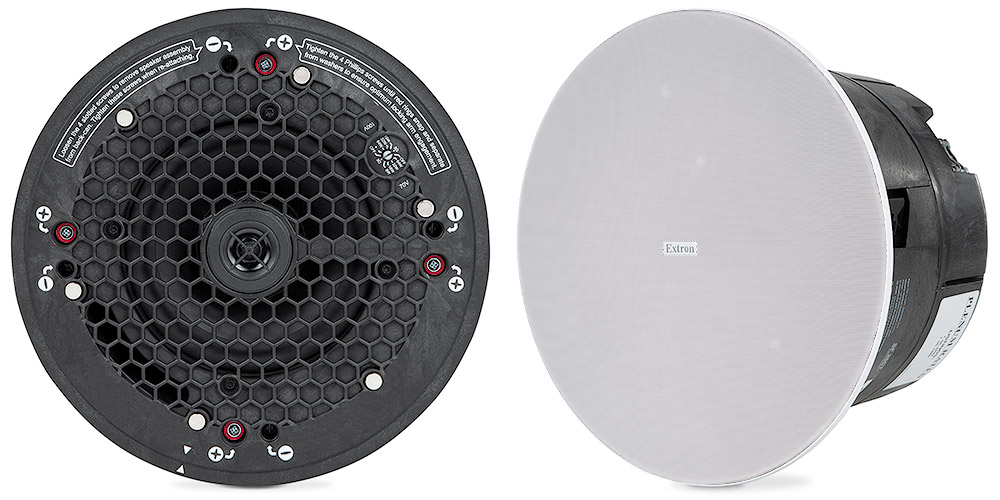
The SoundField XD SF 26CT two-way ceiling speaker features an 8-inch-deep composite back can for use in plenum-rated ceiling environments. The driver complement includes a 6.5-inch woofer coupled to a 3/4-inch ferrofluid-cooled dome tweeter. The SF 26CT offers both direct 8 ohm and 70/100V operation with a behind-the-grille, six-position power selector switch. With high impedance taps at 8, 16, 32, and 64 watts, the SF 26CT is ideal for applications that require a high-power distributed speaker system. It also features a finely perforated round metal grille (or optional square grille) that attaches magnetically to the baffle.
JBL LCT 81C/TM
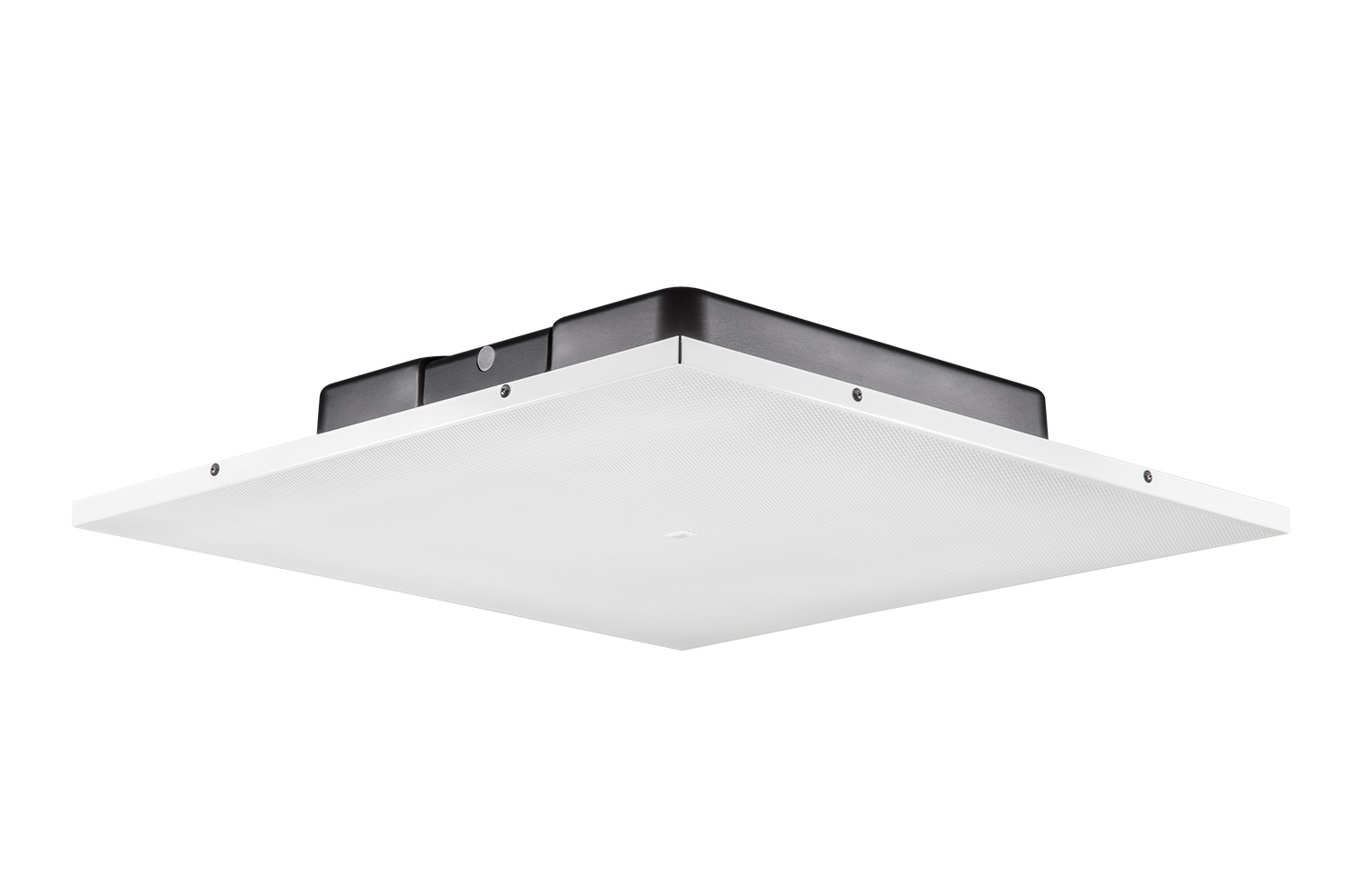
The LCT 81C/TM delivers high output and intelligibility for classrooms, offices, paging systems, airports, retail stores, and any place where speech and music clarity are critical. The low-profile speaker features a highly efficient 8-inch dual-cone driver with 1-inch voice coil and high-performance transformer. Its wide 100-degree conical dispersion pattern translates to broader coverage with fewer speakers, and its high 96 dB sensitivity means loud and clear sound even at low tap settings. Because the speaker looks like a ceiling vent, it’s ideal for venues where the architect or visual designer doesn’t want the appearance of a ceiling speaker.
Leon Axis Pro Design Series
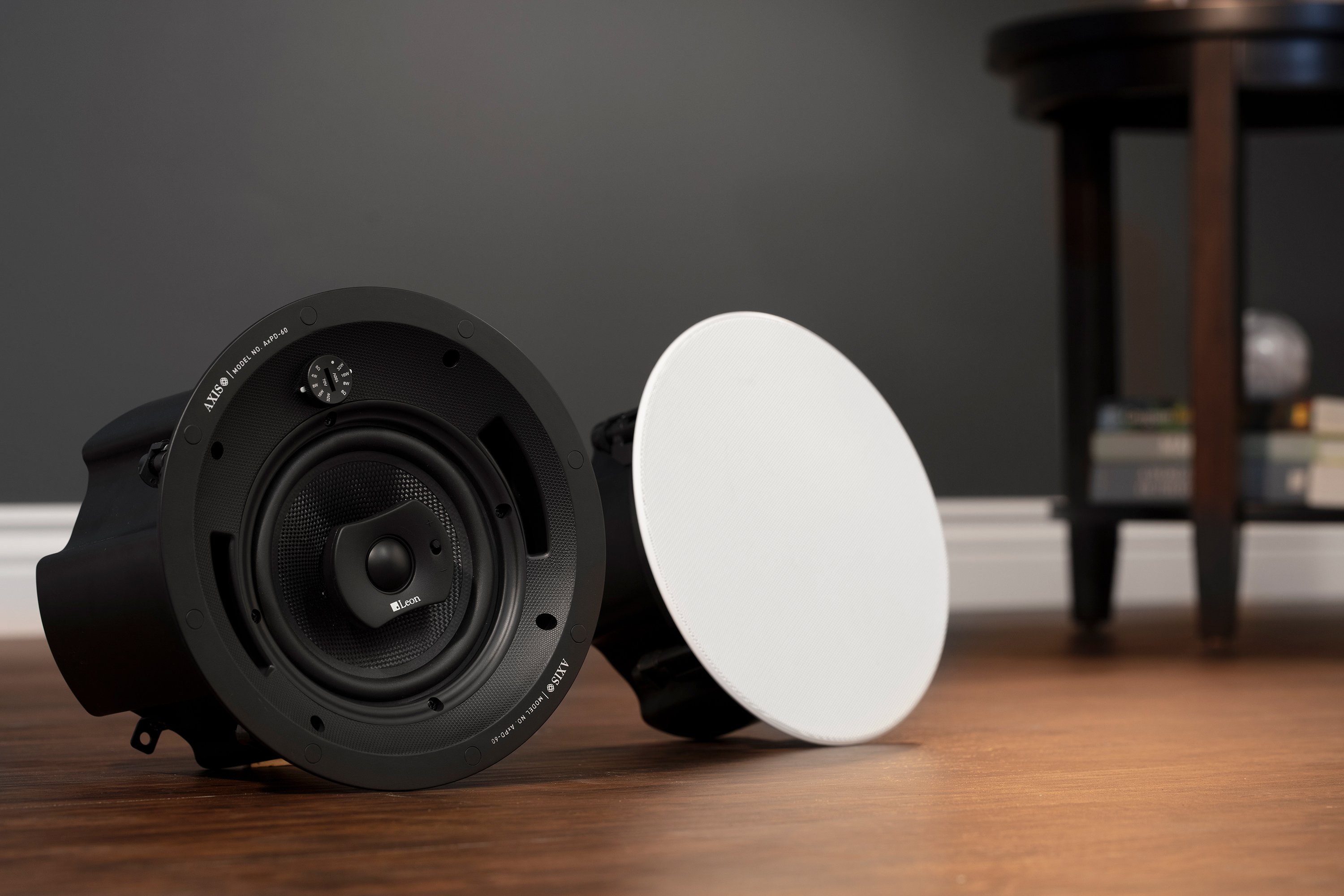
Leon’s Axis Pro Design Series of in-ceiling speakers offers high-quality performance, flexibility, and design. Combining premium, full-range audio with a discreet aesthetic, Axis Pro Design is ideal for ambient background music, as additional sound reinforcement for distributed audio, or as main speakers in any commercial space. Commercial-grade and UL listed with plenum-rated steel back cans and 70V transformers, Axis Pro Design is available in three models and comes standard with magnetically attached circular grills that can be upgraded to square and custom painted to match any color code or paint swatch.
Lowell ES Series
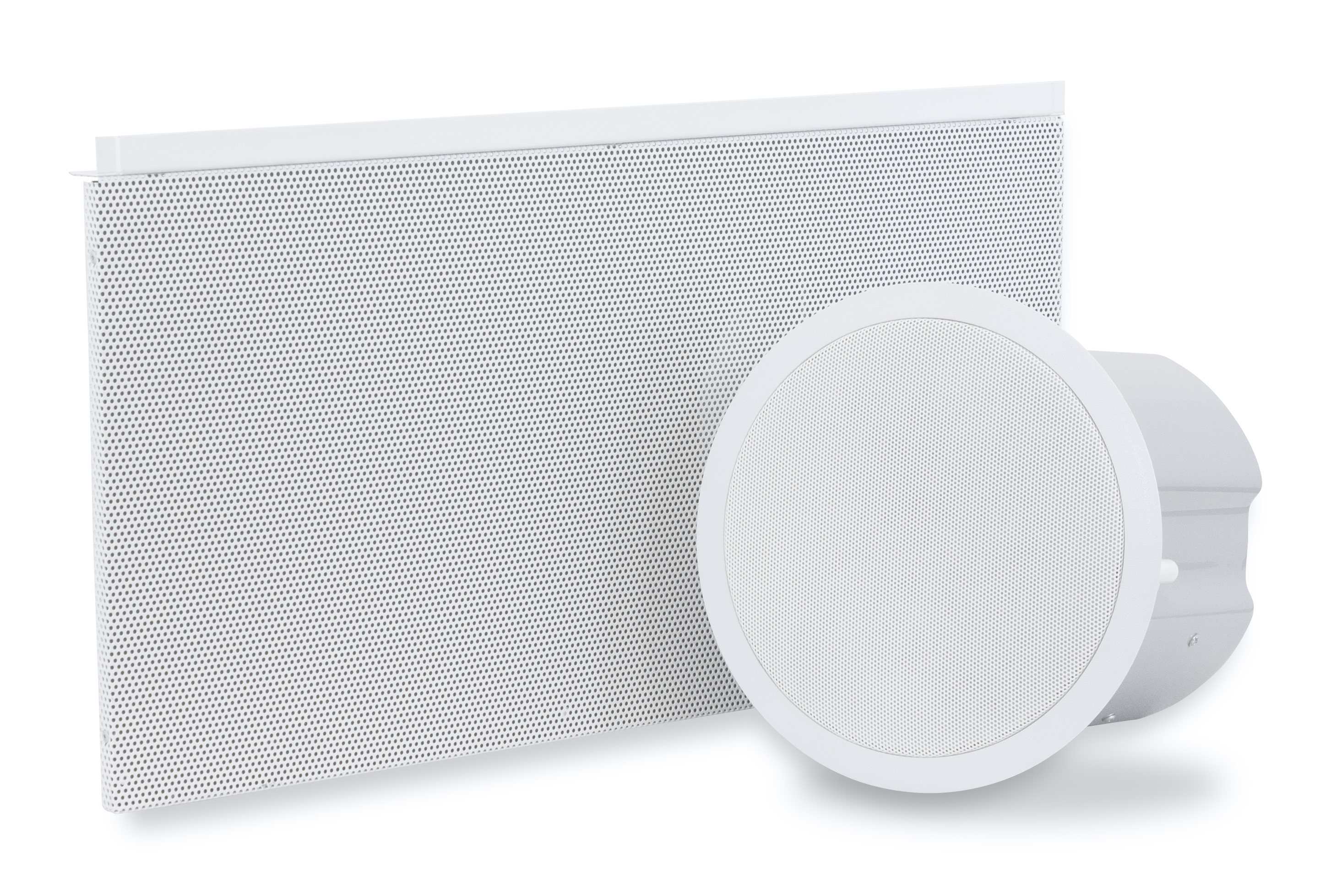
Lowell’s ES Series in-ceiling speakers offer timesaving, ready-to-install designs. The ES Series features a clean look, enhanced sound, and fast installation in a UL listed product that is well suited for a variety of commercial and institutional applications in drywall, wood, and tile ceilings. Six available models range from 4-8-inch drivers paired with a transformer for 70V applications. The ES Series ensures excellent intelligibility for speech and full-frequency response for music in a self-contained package designed with contractors and systems integrators in mind.
Pure Resonance Audio C3
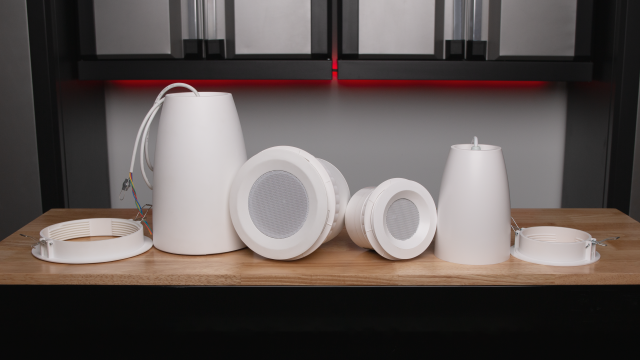
Compact and lightweight, the Pure Resonance Audio C3 3-inch micro commercial ceiling speaker seamlessly blends into ceilings with its recessed design. Equipped with a built-in 70/100V transformer and 8-ohm bypass, these speakers are perfect for diverse business environments like offices, retail stores, restaurants, and hospitality venues. Despite its small footprint, the C3 offers enhanced audio quality, ideal for background music and sound masking. The speaker is quick to install using the included screw-on easy-mounting ring for drop tile ceilings, with optional mounting kits available for drywall or open ceiling applications.
Shure Microflex MXN5W-C
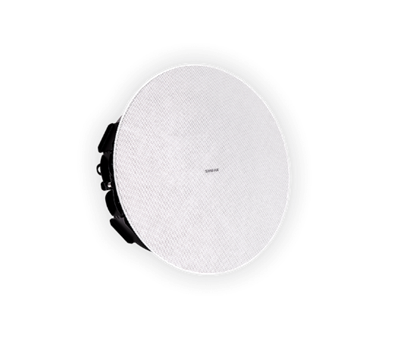
Microsoft Teams Certified, the Microflex MXN5W-C networked ceiling loudspeaker delivers premium audio performance optimized for voice intelligibility, with a low-profile design for easy installation in drop ceiling configurations. It integrates seamlessly with Shure’s ecosystem of networked hardware and software, including Microflex Advance (MXA) Array Microphones and IntelliMix DSP, to deliver a complete audio solution with AES-256 encryption and enhanced AV conferencing performance. With Shure Designer System Configuration software, MXN5W-C users can visualize speaker coverage alongside Shure MXA microphones and Shure networked devices for ease of deployment.
Snap One Triad PDX Series
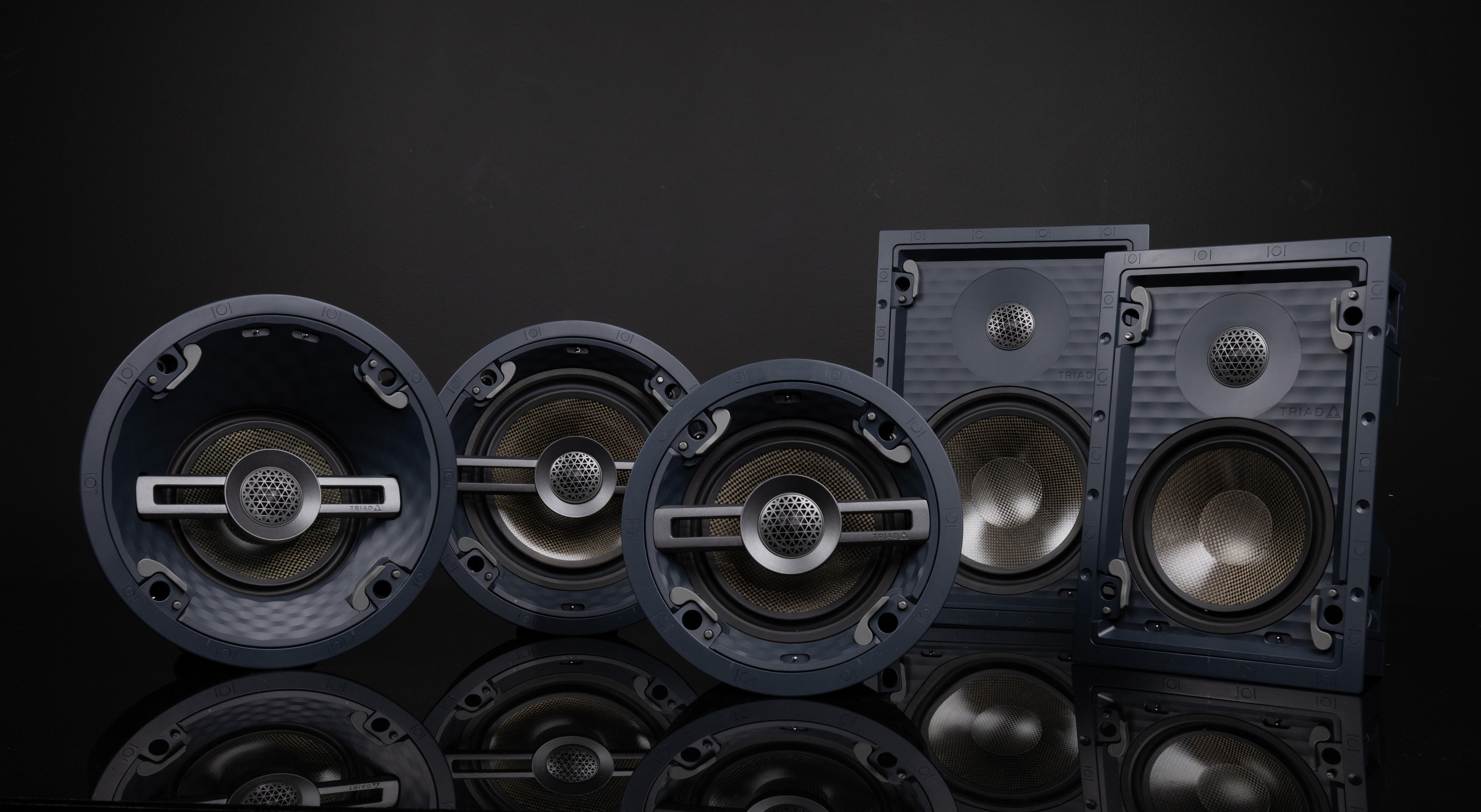
Triad PDX speakers pair premium audio performance with a simplified installation experience made possible by Push Lock by Swarm technology. The series includes 13 speakers and 19 accessories, including optional custom-colored grilles, rear enclosure, and pre-construction brackets. Triad PDX enhances the listening experience by using high-performance materials and components like carbon fiber, Kevlar, Teteron, dual voice coils, chemically etched metal components, and more. Unique to Triad PDX, the Kevlar infusion into carbon fiber for the woofer creates a premium audio experience.
SoundTube CM-BGM-II-US Series

SoundTube Entertainment’s series of BAA-compliant in-ceiling speakers includes four models that combine high-performance audio with sleek, modern aesthetics to deliver clear background music. Designed specifically for low and suspended ceilings, SoundTube’s CM-BGM in-ceiling speakers reduce installation time with the SpeedWing constant-tension mounting system. The CM Series incorporates low profile styling and seamless coverage in a one-piece integrated unit. Applying BroadBeam technology, the CM-BGM models greatly expand the coverage area, meaning fewer speakers are needed for full frequency dispersion.
TOA FB-3862CU
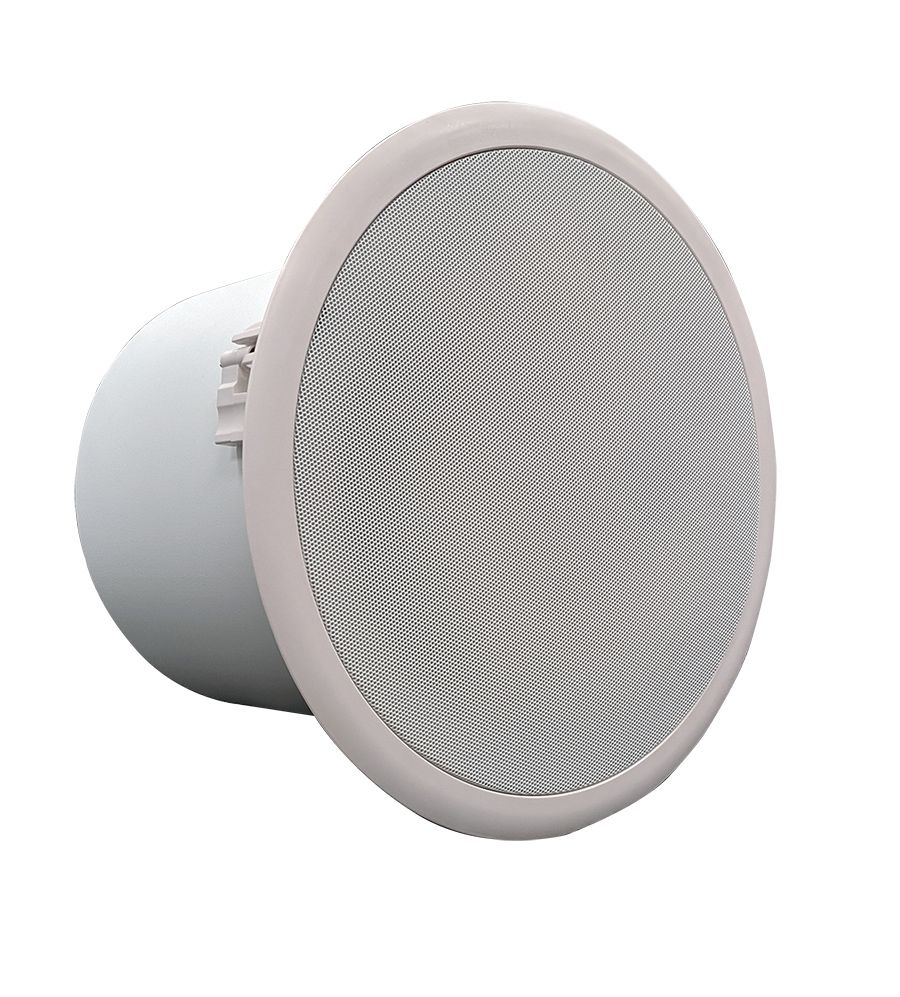
Part of the TOA F-Series of high-performance, flush-mount ceiling speakers, the FB-3862CU is a ceiling subwoofer assembly for low-frequency enhancement of distributed loudspeaker systems. A 60W, 70/100V transformer is included, and the bandpass design eliminates the need for a bi-amplified system. The 8-ohm bypass allows for applications using electronic crossovers and dedicated low impedance power amplifiers. The FB-3862CU subwoofer rounds out TOA's F-Series premier speaker line to offer a full spectrum sonic experience suitable for retail environments, restaurants, lounges, conference rooms, and any application where music or video content require high-quality sound.
Vanco Beale Street TIC651
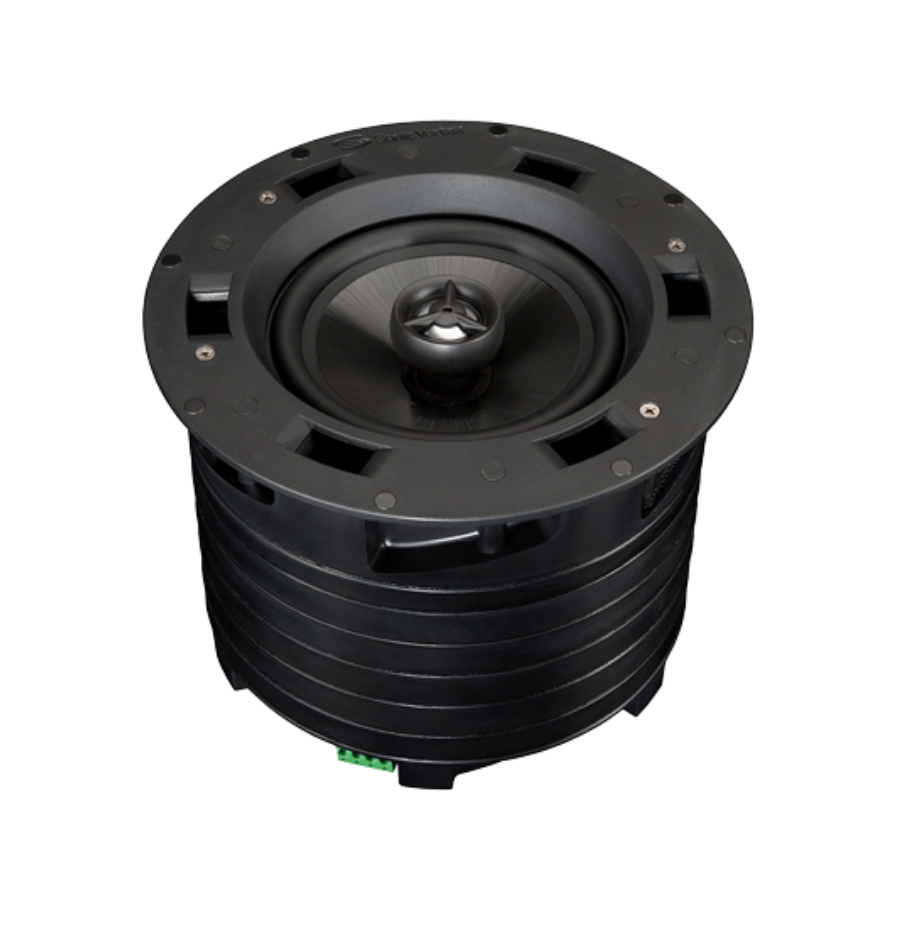
The Beale Street TIC651 70/100V architectural speaker is a versatile solution for clear sound in commercial spaces. The 6.5-inch fluted injected poly woofer and 1-inch aluminum dome tweeter produce a frequency range of 48 Hz to 24 kHz and a sensitivity of 89 dB for detailed, accurate sound reproduction. The TIC651 is outfitted with a butyl rubber surround, patented Sonic Vortex ported transmission line, and magnetic, bezel-less grille for easy integration that preserves room aesthetics. Sonic Vortex technology enables the TIC651 to absorb sound waves and redirect them back into a room, preventing audio bleed in commercial applications where privacy is a prime concern.
Yorkville C165W
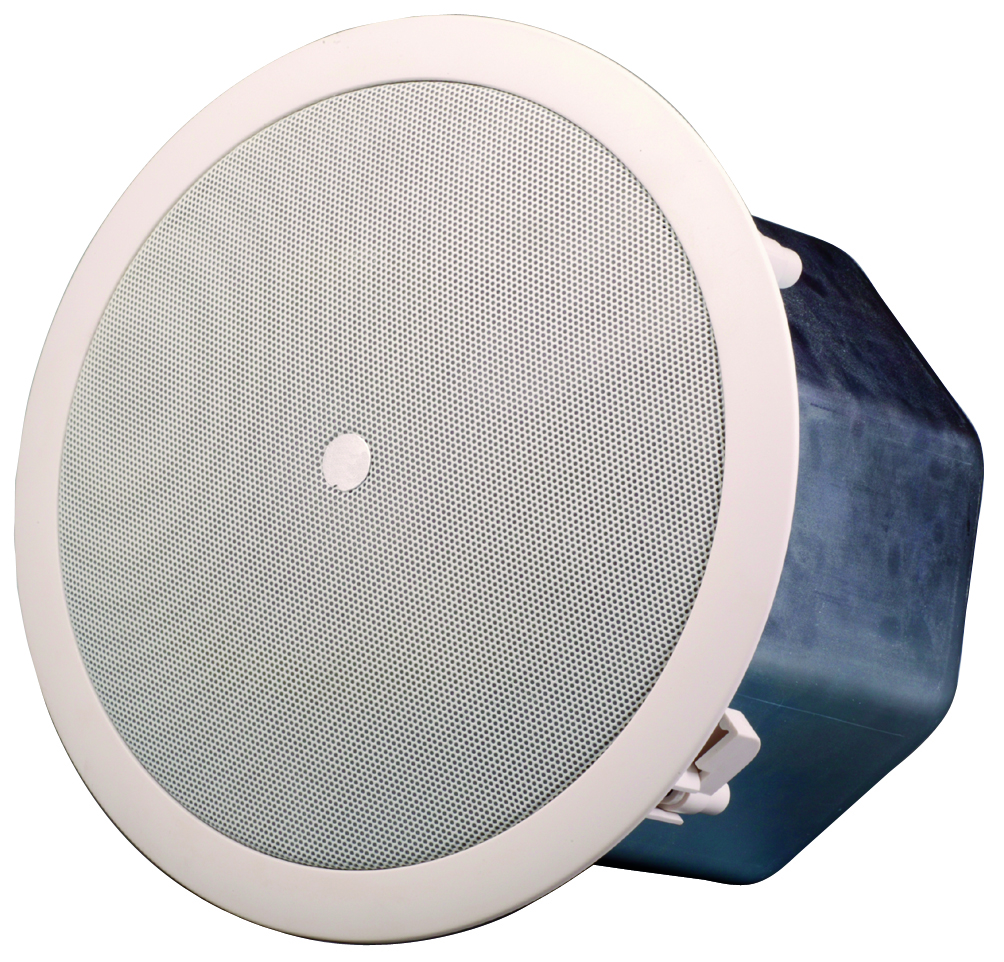
The 60W, 6.5-inch C165W is a high-performance ceiling mount loudspeaker. Ideal for any background music or paging system where sound quality is a priority, the speaker is made for louder club or restaurant/retail environments. Featuring an innovative design and employing high-quality materials, the C165W maintains quality performance from a compact ceiling loudspeaker. It contains a coaxial 6.5-inch woofer and 3/4-inch titanium coated tweeter. Built-in 70V taps at 7.5, 15, 30, or 60W operation means that high-fidelity, full-range sound can be achieved over an extremely wide coverage pattern area.
